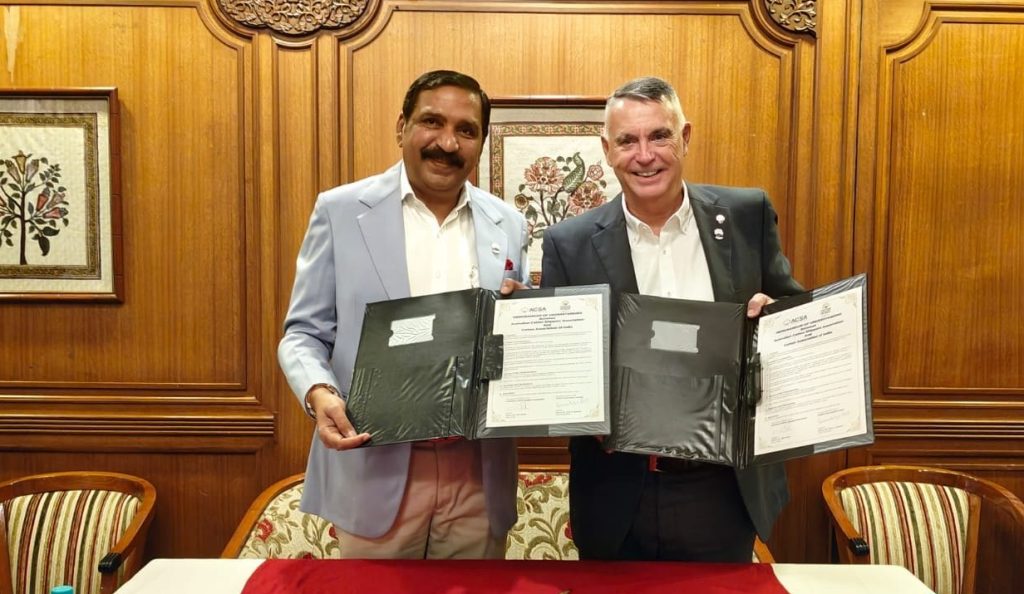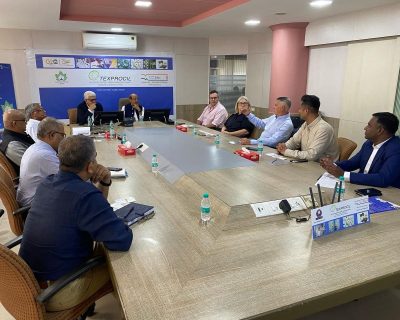
Cotton Association of India president Atul Ganatra and Australian Cotton Shippers Association chair Cliff White following the signing of an MOU agreement. Source: Austrade
THE AUSTRALIAN Cotton Shippers Association (ACSA) has signed a memorandum of understanding with the Cotton Association of India (CAI) which will lay the foundation for stronger bilateral cooperation between the nations.
It comes almost one year after ASCA finalised a MOU agreement with the American Cotton Shippers Association and the Brazilian Cotton Shippers Association that was also designed to advance the global industry through greater cooperation.
The signing came at the culmination of an eight-day visit to India and Bangladesh by a small continent of ASCA representatives.
Alongside talks with the CIA, the delegation — including ACSA members Cliff White, Joel Hatherell, Shay Dhareula and CEO Jules Willis — also met with representatives from India’s Textile Export Promotion Council (TEXPROCIL), the Southern India Mills’ Association, the Indian Cotton Federation, and a range of agents, cotton buyers and spinning mill operators.
They also met with the Australian Consul General from the Department of Agriculture, Fisheries and Forestry and Austrade’s Trade and Investment Commissioner to discuss topics such as Australia-India trade relations, India’s economic outlook, the impact of newly released US tariffs, Australian cotton exports to India, and the dynamics of the local market.
In a LinkedIn post, Austrade South Asia said the signing of the MOU was “a highlight of the visit”.
“This is a significant step forward in reinforcing the cotton supply chain between two powerhouse cotton nations – and driving long-term sustainability, trade, and mutual growth,” the post said.
“The MOU focuses on: sharing market intelligence and production trends; collaborating on global pricing and forecasts; improving market access and advocating for enhanced tariff-free quotas for Australian cotton; and promoting reciprocal support for both markets.”
India ranked as Australia’s third-largest cotton export market in March, accounting for 12 percent of exports, behind China at 28pc and Vietnam 26pc, according to the latest ASCA Market Report.
Under the Australia-India Economic Cooperation and Trade Agreement (AI-ECTA), which came into effect in December 2022, India established a tariff rate quota allowing 51,000 tonnes of Australian cotton to enter duty-free each year.
This quota represented a substantial reduction from the previous 11 percent tariff imposed on Australian cotton exports.
Since taking effect, Australian exporters have made use of 99pc of this quota amount.

ACSA had discussions with India’s Textile Export Promotion Council. Photo: Austrade
DAFF data shows that, as of 31 March, 5,839 tonnes of cotton had been exported to India under the AI-ECTA, with 5,339t shipped under the “allocated” quota and a further 500t under the “first-come, first-served” provision.
The final position for the 2024 quota year at 50,719t shipped to India, with a similar amount of 50,690t shipped at the end of the 2023 quota year.
During in-market trips to India since December 2022, Cotton Australia and other industry representatives have pushed the case for increasing this quota to more than 100,000t.
US, Brazil cooperation
Alongside strengthening the relationship with CAI, ACSA is also continuing to collaborate with the Brazilian and American cotton shipping industry groups as part of last year’s MOU agreement.
During a Post Farm-Gate Forum held at Toowoomba in March, Mr White said the communication between the three associations continued to be a positive initiative.
“We’re all competitors but at the end of the day we are all involved in the cotton industry,” Mr White said.
“It’s in everyone’s interest to promote a united front for cotton in a global marketplace.”
He said a key focus of the organisation was to promote the benefits of cotton fibres over man-made materials.
He pointed to the international Make the Label Count coalition, which brings together organisations representing natural fibre producers and environmental groups, and aims to ensure sustainability claims for textiles in the European Union are credible and science-based.
“One of the things we are talking about at the moment is Make the Label Count and whether the global cotton industry should do something on its own.
“They’re only the very early conversations that we’re having but it’s certainly something that all three associations are very interested in.”